Citroen DS4 RHD 2015.5 1.G User Guide
Manufacturer: CITROEN, Model Year: 2015.5, Model line: DS4 RHD, Model: Citroen DS4 RHD 2015.5 1.GPages: 436, PDF Size: 10.13 MB
Page 11 of 436
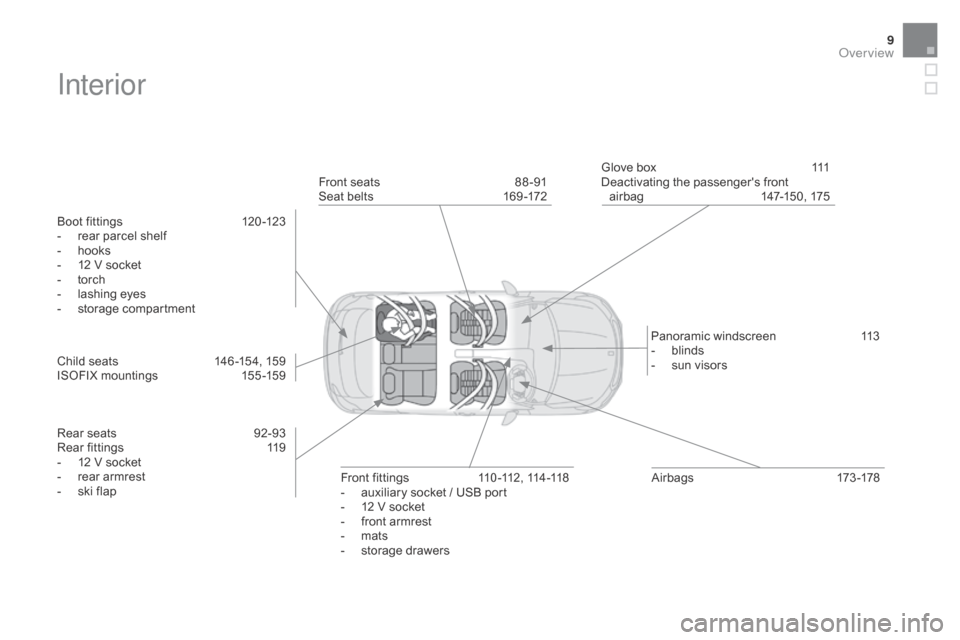
9
Interior
Boot fittings 120 -123
- r ear parcel shelf
-
h
ooks
-
1
2 V socket
-
t
orch
-
l
ashing eyes
-
s
torage compartment
Child seats
1
46 -154, 159
ISOFIX mountings
1
55 -159
Rear seats
9
2-93
Rear fittings
1
19
-
1
2 V socket
-
r
ear armrest
-
s
ki flap Front seats
8
8 -91
Seat belts
1
69 -172Glove box
1
11
Deactivating the passenger's front airbag
1
47-150, 175
A i r b a g s
17
3 -178
Front fittings
1
10 -112, 114-118
-
a
uxiliary socket / USB port
-
1
2 V socket
-
f
ront armrest
-
m
ats
-
s
torage drawersPanoramic windscreen
1
13
-
b
linds
-
s
un visors
Over view
Page 12 of 436
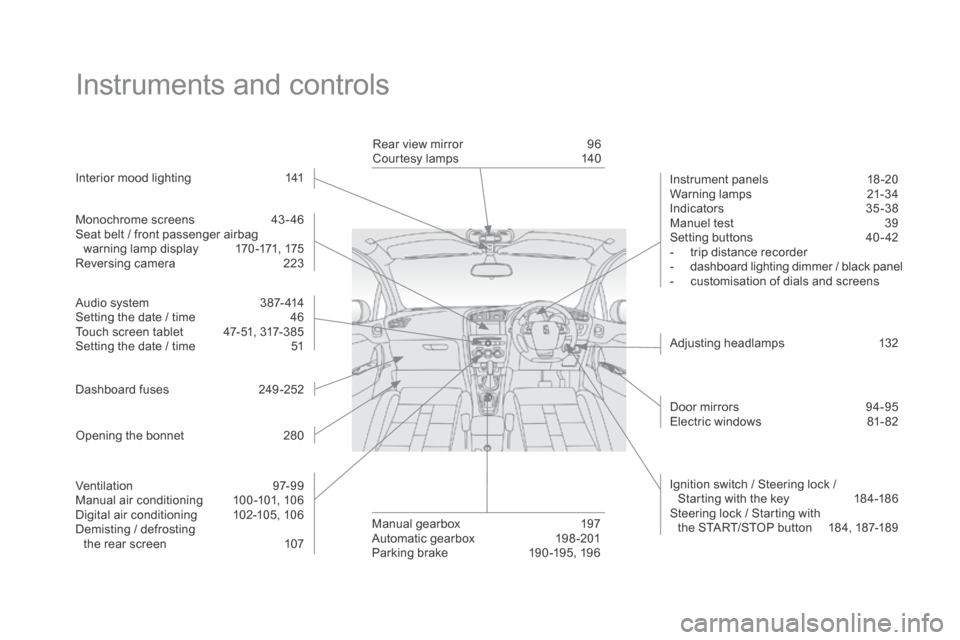
Instruments and controls
Monochrome screens 43-46
Seat belt / front passenger airbag warning lamp display
1
70 -171, 175
Reversing camera
2
23
Audio system
3
87- 414
Setting the date / time
4
6
Touch screen tablet
4
7-51, 317-385
Setting the date / time
5
1
Dashboard fuses
2
49 -252
Opening the bonnet
2
80Rear view mirror
9
6
Courtesy lamps
1
40
Adjusting headlamps
1
32
Manual gearbox
1
97
Automatic gearbox
1
98 -201
Parking brake
1
90 -195, 196
Interior mood lighting
1
41
Door mirrors
9
4-95
Electric windows
8
1- 82
Ignition switch / Steering lock /
Starting with the key
1
84-186
Steering lock / Starting with the START/STOP button
1
84, 187-189
Instrument panels
1
8 -20
Warning lamps
2
1-34
Indicators 35 -38
Manuel test 3 9
Setting buttons
4
0 - 42
-
t
rip distance recorder
-
d
ashboard lighting dimmer / black panel
-
c
ustomisation of dials and screens
Ventilation
9
7-99
Manual air conditioning
1
00 -101, 106
Digital air conditioning
1
02-105, 106
Demisting / defrosting the rear screen
1
07
Page 13 of 436

11
Instruments and controls
Multifunction steering wheel
Speed limiter 215 -217
Cruise control 2 18 -220
Memorising speeds
2
13 -214
Lighting controls
1
26 -130
Adjusting the steering wheel
9
3 Audio and telephone controls for the
Audio system 3 89
Audio and telephone controls for the touch screen tablet
3
20
Wiper controls
1
35 -139
Trip computer
5
2-56
Horn
16
5
Over view
Page 14 of 436
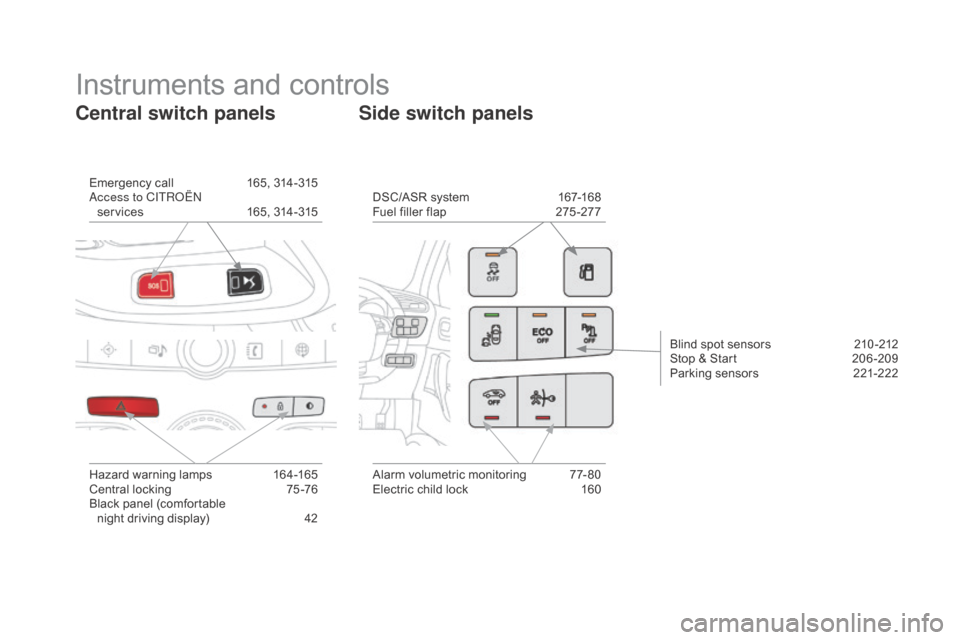
Emergency call 165, 314-315
Access to CITROËN services
1
65, 314-315DSC/ASR system
1 67-168
Fuel filler flap
2
75 -277
Hazard warning lamps
1
64-165
Central locking
7
5 -76
Black panel (comfortable night driving display)
4
2Alarm volumetric monitoring
7
7- 80
Electric child lock
1
60
Side switch panels
Central switch panels
Instruments and controls
Blind spot sensors 2 10 -212
Stop & Start 2 06 -209
Parking sensors
2
21-222
Page 15 of 436
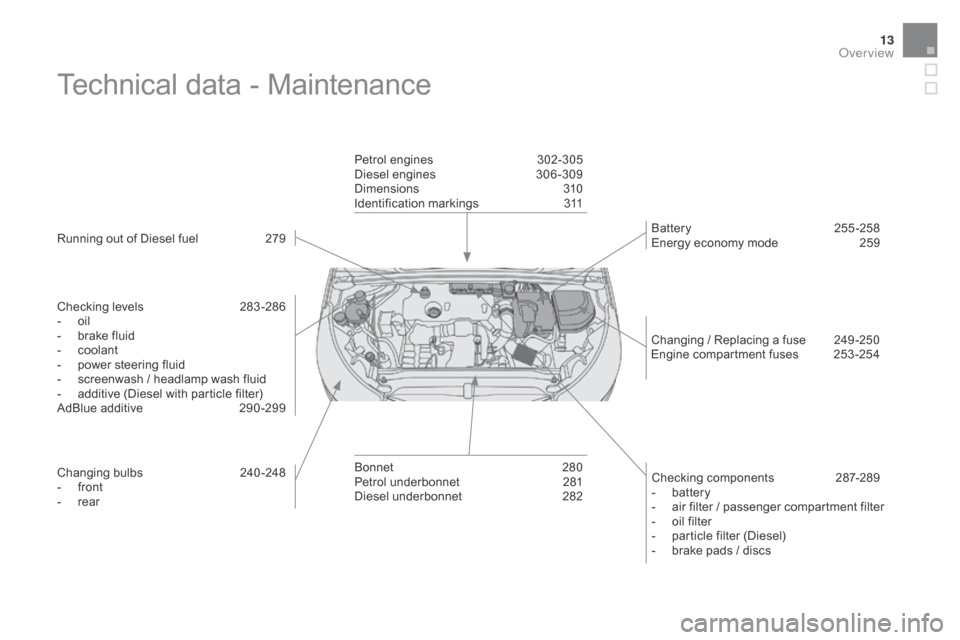
13
Technical data - Maintenance
Running out of Diesel fuel 279
Checking levels
2
83 -286
-
o
il
-
b
rake fluid
-
c
oolant
-
p
ower steering fluid
-
s
creenwash / headlamp wash fluid
-
a
dditive (Diesel with particle filter)
AdBlue additive
2
90 -299
Changing bulbs
2
40-248
-
f
ront
-
r
ear Petrol engines
3
02-305
Diesel engines
3
06 -309
Dimensions
3
10
Identification markings
3
11
Bonnet
2
80
Petrol underbonnet
2
81
Diesel underbonnet
2
82Checking components
2
87-289
-
b
attery
-
a
ir filter / passenger compartment filter
-
o
il filter
-
p
article filter (Diesel)
-
b
rake pads / discs
Battery 2
55 -258
Energy economy mode 2 59
Changing / Replacing a fuse
2
49 -250
Engine compartment fuses
2
53 -254
Over view
Page 16 of 436
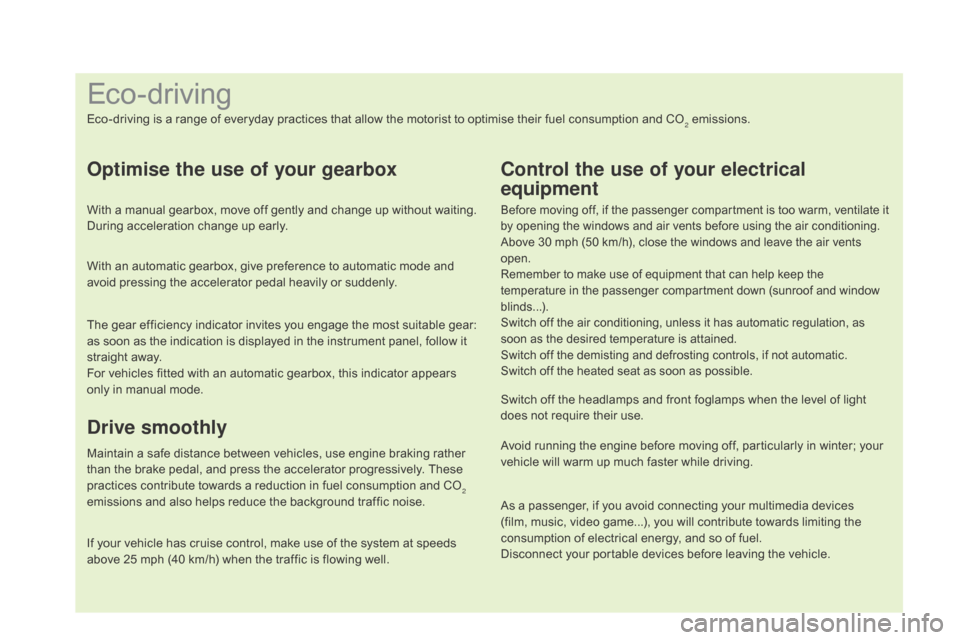
As a passenger, if you avoid connecting your multimedia devices
(film, music, video game...), you will contribute towards limiting the
consumption of electrical energy, and so of fuel.
Disconnect your portable devices before leaving the vehicle.
Eco-driving
Eco-driving is a range of everyday practices that allow the motorist to optimise their fuel consumption and CO2 emissions.
Optimise the use of your gearbox
With a manual gearbox, move off gently and change up without waiting.
During acceleration change up early.
With an automatic gearbox, give preference to automatic mode and
avoid pressing the accelerator pedal heavily or suddenly.
The gear efficiency indicator invites you engage the most suitable gear:
as soon as the indication is displayed in the instrument panel, follow it
straight away.
For vehicles fitted with an automatic gearbox, this indicator appears
only in manual mode.
drive smoothly
Maintain a safe distance between vehicles, use engine braking rather
than the brake pedal, and press the accelerator progressively. These
practices contribute towards a reduction in fuel consumption and CO
2
emissions and also helps reduce the background traffic noise.
If your vehicle has cruise control, make use of the system at speeds
above 25 mph (40 km/h) when the traffic is flowing well.
Control the use of your electrical
equipment
Before moving off, if the passenger compartment is too warm, ventilate it
by opening the windows and air vents before using the air conditioning.
Above 30 mph (50 km/h), close the windows and leave the air vents
open.
Remember to make use of equipment that can help keep the
temperature in the passenger compartment down (sunroof and window
blinds...).
Switch off the air conditioning, unless it has automatic regulation, as
soon as the desired temperature is attained.
Switch off the demisting and defrosting controls, if not automatic.
Switch off the heated seat as soon as possible.
Switch off the headlamps and front foglamps when the level of light
does not require their use.
Avoid running the engine before moving off, particularly in winter; your
vehicle will warm up much faster while driving.
Page 17 of 436
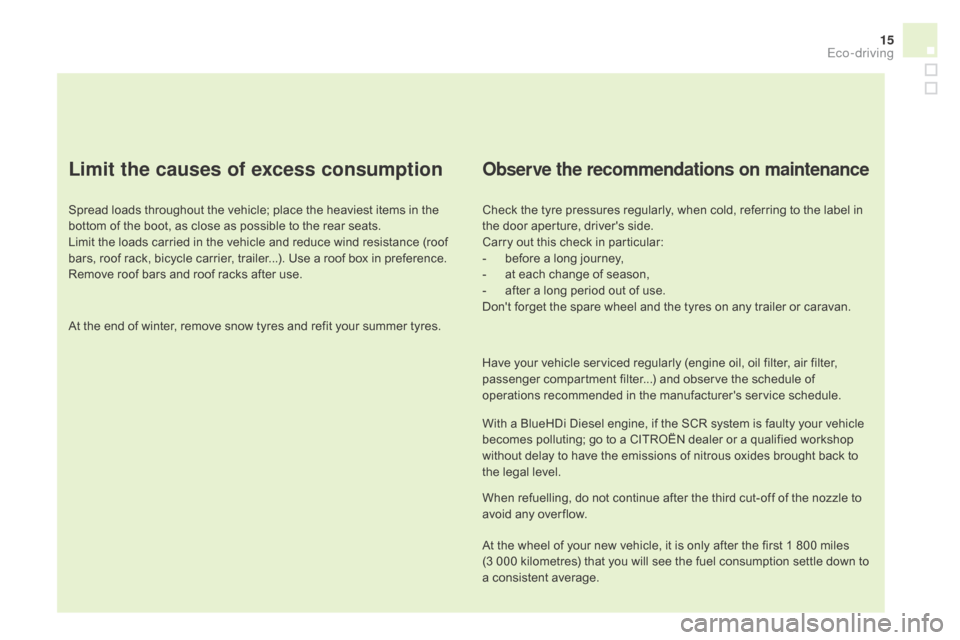
15
Limit the causes of excess consumption
Spread loads throughout the vehicle; place the heaviest items in the
bottom of the boot, as close as possible to the rear seats.
Limit the loads carried in the vehicle and reduce wind resistance (roof
bars, roof rack, bicycle carrier, trailer...). Use a roof box in preference.
Remove roof bars and roof racks after use.
At the end of winter, remove snow tyres and refit your summer tyres.
Observe the recommendations on maintenance
Check the tyre pressures regularly, when cold, referring to the label in
the door aperture, driver's side.
Carry out this check in particular:
-
b
efore a long journey,
-
a
t each change of season,
-
a
fter a long period out of use.
Don't forget the spare wheel and the tyres on any trailer or caravan.
Have your vehicle serviced regularly (engine oil, oil filter, air filter,
passenger compartment filter...) and observe the schedule of
operations recommended in the manufacturer's service schedule.
With a BlueHDi Diesel engine, if the SCR system is faulty your vehicle
becomes polluting; go to a CITROËN dealer or a qualified workshop
without delay to have the emissions of nitrous oxides brought back to
the legal level.
When refuelling, do not continue after the third cut-off of the nozzle to
avoid any over flow.
At the wheel of your new vehicle, it is only after the first 1 800 miles
(3
000 kilometres) that you will see the fuel consumption settle down to
a consistent average.
Eco-driving
Page 18 of 436
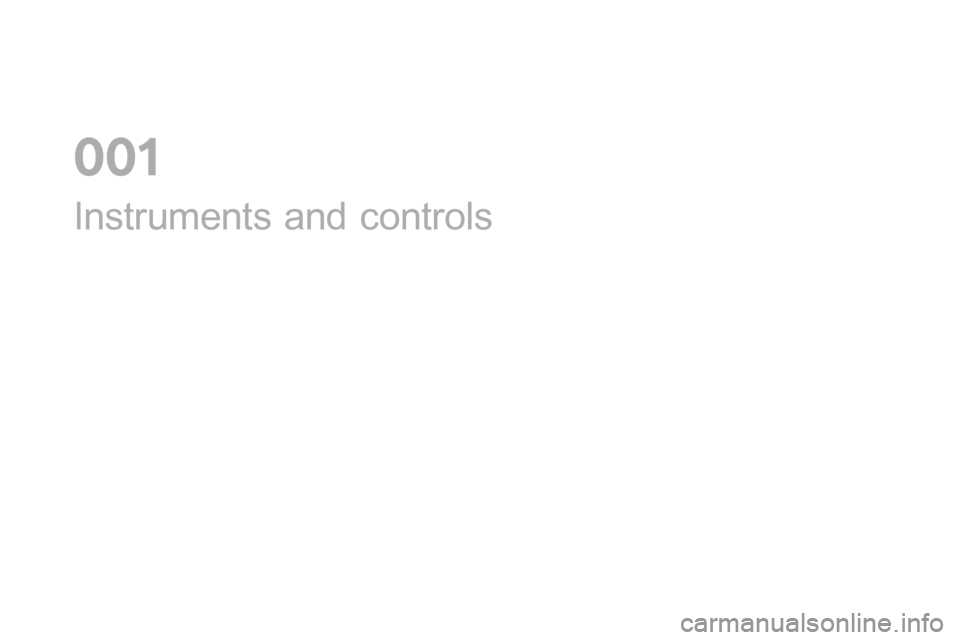
Instruments and controls
0
Page 19 of 436
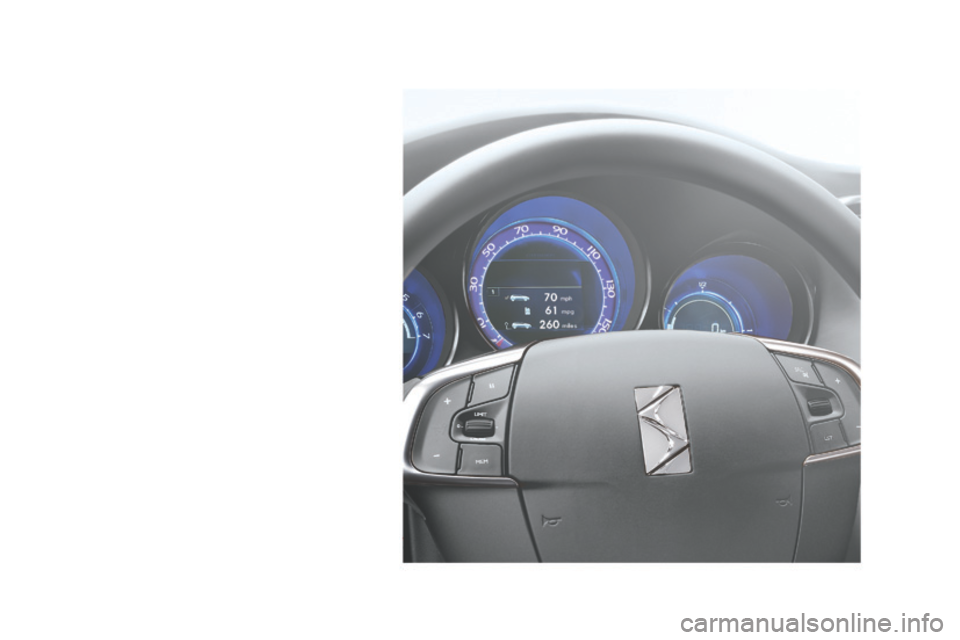
Page 20 of 436
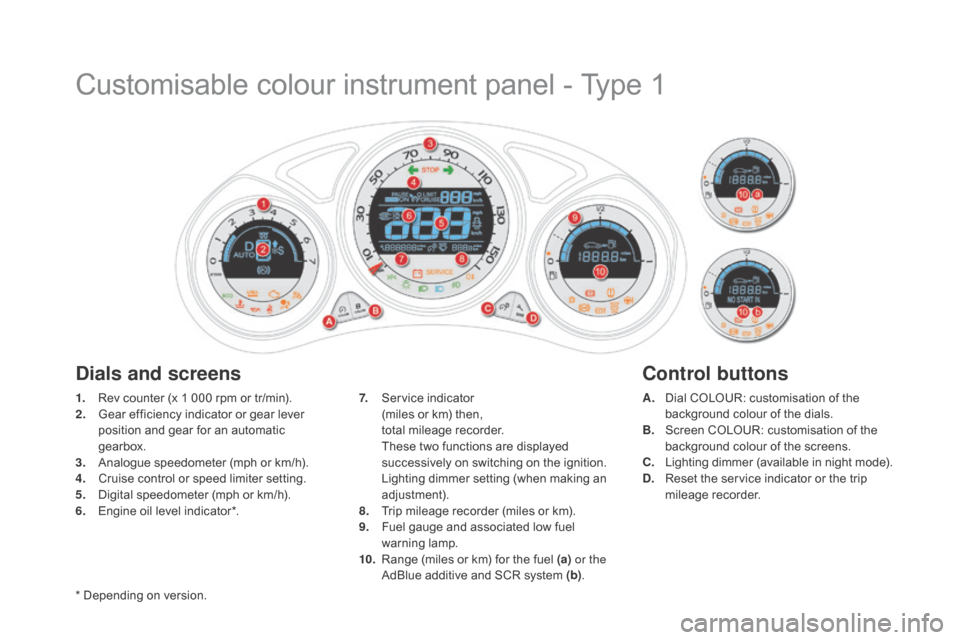
Customisable colour instrument panel - Type 1
1. Rev counter (x 1 000 rpm or tr/min).
2. Gear efficiency indicator or gear lever
position and gear for an automatic
gearbox.
3.
A
nalogue speedometer (mph or km/h).
4.
C
ruise control or speed limiter setting.
5.
D
igital speedometer (mph or km/h).
6.
E
ngine oil level indicator*.
dials and screens Control buttons
7. Service indicator (
miles or km) then,
t
otal mileage recorder.
T
hese two functions are displayed
successively on switching on the ignition.
L
ighting dimmer setting (when making an
adjustment).
8.
T
rip mileage recorder (miles or km).
9.
F
uel gauge and associated low fuel
warning lamp.
10.
R
ange (miles or km) for the fuel (a) or the
AdBlue additive and SCR system (b) .A. D
ial COLOUR: customisation of the
background colour of the dials.
B.
S
creen COLOUR: customisation of the
background colour of the screens.
C.
L
ighting dimmer (available in night mode).
d
.
R
eset the service indicator or the trip
mileage recorder.
*
Depending on version.